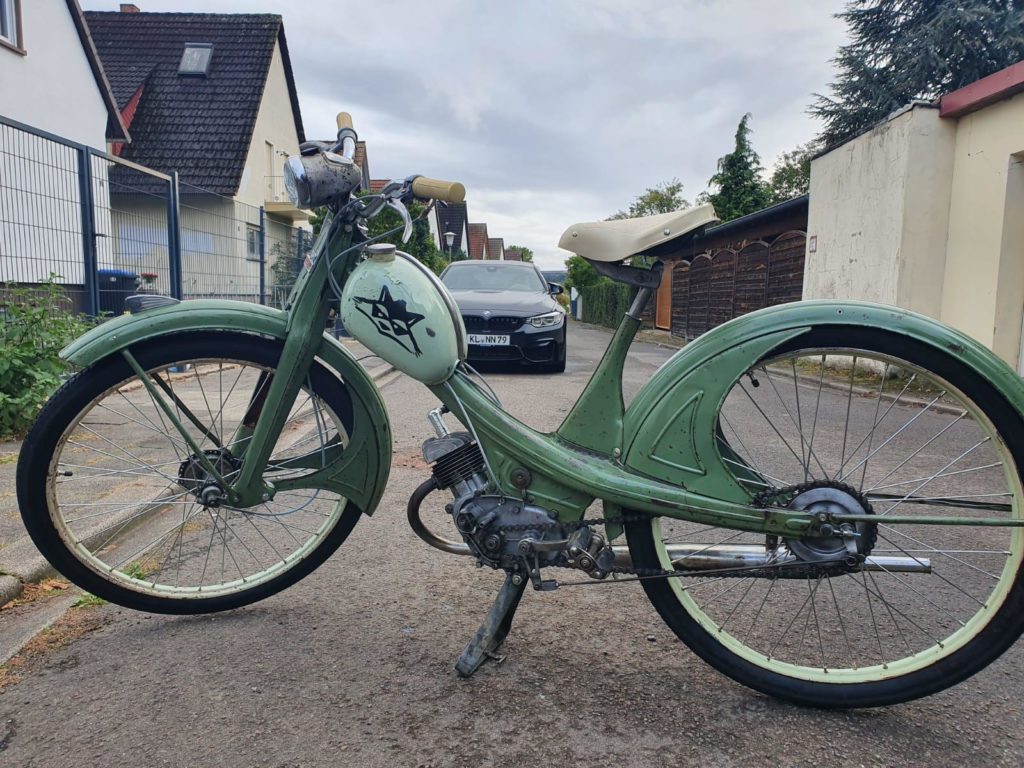
General Information:
Introduced in 1953 the NSU Quickly was one of the vehicles that brought mobility to the german people in a large scale. Reliable, cheap and easy to treat it was a asked good after the second world war. It was THE vehicle that formed the term „Moped“. 1.5 million units were produced of which plenty are still available. Although many have survived they are a rare thing in modern days traffic. I bought this particular one, because it was originally sold the village where I grew up, and was only passed around in the neighbourhood until the present day. Many older folks in the village can tell stories about this particular one, so I felt dedicated to bring it back on the road. The condition was pretty bad and it had to endure more then one spill, but the engine was still turning free and it was more or less complete.
The restauration itself:
-Preliminary planning:
The plan was to keep the original substance and try to keep as much of the original paint as possible, only coating everything with transparent paint. At the same time, we wanted some aspects of the vehicle to be clean and nicely done. So we decided against using the original handlebar, original spokes or the saddlecloth, so now what we have is a mixture of visibly aged parts and new and shiny aspects.
The rather unideal condition was no result of corrosion. Rather, it seemed to have been abused by youngsters for quite a while of its life and suffered (typical for low budget vehicles) some quite amateurish reparation attempts. That is why quite a bit of the original paint was saved.

-procedure:
First we seperated the assembly groups like front end or main frame from each other. Cleaning the engine and refurbishing cylinder, cylinder cover and crankcase were the first major tasks performed, since we afterwards started to refurbish single items and one by one attach it to the engine, so the vehicle would start reemerging around its engine.
engine:
The gearbox, and clutch still seemed to work which is why we took the risk to not disassemble them. Still, although the engine still moved when turned over, we removed cylinder and cylinder cover to see if everything was in order with these. Since it is such a small and simple engine, that is a part that is almost not worth mentioning.
Since we cleaned all the parts mechanically with brushes, cotton buds, brake cleaner/oil and brass wire-bruhes, that was more of a task then the assembly work itself.
„Cleaning is one major aspect of a mechanics daily business“ – a sentence that my former foremaster often mentioned – really gains weight when restoring older(dirty) vehicles.
wheels:
The wheels were the parts that devoured most of the time, if you compare them with the other assembly units. We decided to use thicker stainless steel spokes instead of the original ones. For no other specific reason then optics. The rims themselves were badly bent and twisted, and even repaired on one spot. Clamps were built out of wood to be able to mount them on a vise. There we tried to straighten then tougher twists by bending and compressing them on various spots with moderate success. The remaining twist would have to be straightened out with the spokes.
The brake drums were slightly skimmed on a lathe while reusing the original brake shoe.
The invisible parts of the wheels were then coated with rust converting primer after all parts being cleaned with wirebrush and emery sponges.
Now the spoke….. to be continued..
